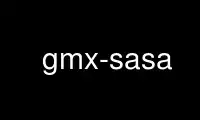
This is the command gmx-sasa that can be run in the OnWorks free hosting provider using one of our multiple free online workstations such as Ubuntu Online, Fedora Online, Windows online emulator or MAC OS online emulator
PROGRAM:
NAME
gmx-sasa - Compute solvent accessible surface area
SYNOPSIS
gmx sasa [-f [<.xtc/.trr/...>]] [-s [<.tpr/.gro/...>]] [-n [<.ndx>]]
[-o [<.xvg>]] [-odg [<.xvg>]] [-or [<.xvg>]] [-oa [<.xvg>]]
[-tv [<.xvg>]] [-q [<.pdb>]] [-b <time>] [-e <time>]
[-dt <time>] [-tu <enum>] [-xvg <enum>] [-[no]rmpbc]
[-[no]pbc] [-sf <file>] [-selrpos <enum>] [-probe <real>]
[-ndots <int>] [-[no]prot] [-dgs <real>]
[-surface <selection>] [-output <selection>]
DESCRIPTION
gmx sasa computes solvent accessible surface areas. See Eisenhaber F, Lijnzaad P, Argos
P, Sander C, & Scharf M (1995) J. Comput. Chem. 16, 273-284 for the algorithm used. With
-q, the Connolly surface can be generated as well in a .pdb file where the nodes are
represented as atoms and the edges connecting the nearest nodes as CONECT records. -odg
allows for estimation of solvation free energies from per-atom solvation energies per
exposed surface area.
The program requires a selection for the surface calculation to be specified with
-surface. This should always consist of all non-solvent atoms in the system. The area of
this group is always calculated. Optionally, -output can specify additional selections,
which should be subsets of the calculation group. The solvent-accessible areas for these
groups are also extracted from the full surface.
The average and standard deviation of the area over the trajectory can be calculated per
residue and atom (options -or and -oa).
With the -tv option the total volume and density of the molecule can be computed. With
-pbc (the default), you must ensure that your molecule/surface group is not split across
PBC. Otherwise, you will get non-sensical results. Please also consider whether the
normal probe radius is appropriate in this case or whether you would rather use, e.g., 0.
It is good to keep in mind that the results for volume and density are very approximate.
For example, in ice Ih, one can easily fit water molecules in the pores which would yield
a volume that is too low, and surface area and density that are both too high.
OPTIONS
Options to specify input files:
-f [<.xtc/.trr/...>] (traj.xtc) (Optional)
Input trajectory or single configuration: xtc trr cpt gro g96 pdb tng
-s [<.tpr/.gro/...>] (topol.tpr) (Optional)
Input structure: tpr gro g96 pdb brk ent
-n [<.ndx>] (index.ndx) (Optional)
Extra index groups
Options to specify output files:
-o [<.xvg>] (area.xvg)
Total area as a function of time
-odg [<.xvg>] (dgsolv.xvg) (Optional)
Estimated solvation free energy as a function of time
-or [<.xvg>] (resarea.xvg) (Optional)
Average area per residue
-oa [<.xvg>] (atomarea.xvg) (Optional)
Average area per atom
-tv [<.xvg>] (volume.xvg) (Optional)
Total volume and density as a function of time
-q [<.pdb>] (connolly.pdb) (Optional)
PDB file for Connolly surface
Other options:
-b <time> (0)
First frame (ps) to read from trajectory
-e <time> (0)
Last frame (ps) to read from trajectory
-dt <time> (0)
Only use frame if t MOD dt == first time (ps)
-tu <enum> (ps)
Unit for time values: fs, ps, ns, us, ms, s
-xvg <enum> (xmgrace)
Plot formatting: none, xmgrace, xmgr
-[no]rmpbc (yes)
Make molecules whole for each frame
-[no]pbc (yes)
Use periodic boundary conditions for distance calculation
-sf <file>
Provide selections from files
-selrpos <enum> (atom)
Selection reference positions: atom, res_com, res_cog, mol_com, mol_cog,
whole_res_com, whole_res_cog, whole_mol_com, whole_mol_cog, part_res_com,
part_res_cog, part_mol_com, part_mol_cog, dyn_res_com, dyn_res_cog, dyn_mol_com,
dyn_mol_cog
-probe <real> (0.14)
Radius of the solvent probe (nm)
-ndots <int> (24)
Number of dots per sphere, more dots means more accuracy
-[no]prot (yes)
Output the protein to the Connolly .pdb file too
-dgs <real> (0)
Default value for solvation free energy per area (kJ/mol/nm^2)
-surface <selection>
Surface calculation selection
-output <selection>
Output selection(s)
Use gmx-sasa online using onworks.net services
